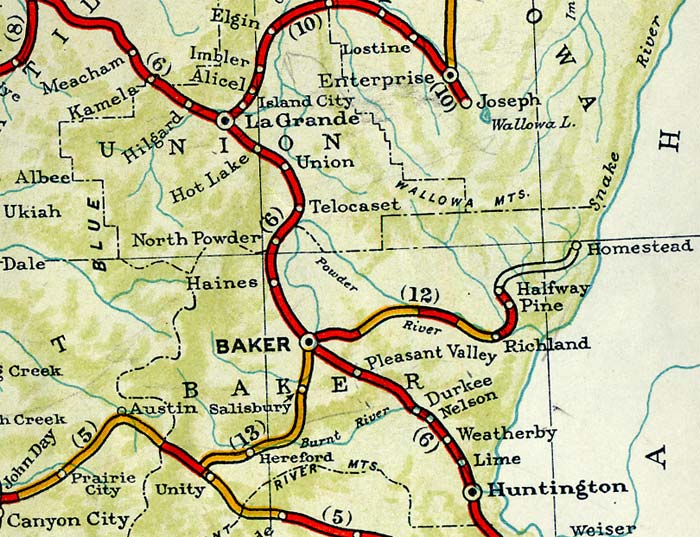 Section map (enlarge image).
Section map (enlarge image).
North of Baker the route runs through the broad Powder River Valley.
HAINES, 92.9 m. (3,334 alt., 431 pop.), is the trading center of a rich farming district. The Elkhorn Range of the Blue Mountains (L) is dominated by five conspicuous peaks; from south to north ELKHORN PEAK (8,922 alt), ROCK CREEK BUTTE (9,097 alt.), HUNT MOUNTAIN (8,232 alt.), named for Wilson Price Hunt; RED MOUNTAIN (8,304 alt.), and TWIN MOUNTAIN (8,920 alt.). Fremont wrote of this range: "It is probable that they have received their name of the Blue Mountains from the dark blue appearance given to them by the pines."
A couple miles north of Haines is the Ford of Powder River called in
early days the Lone Tree Crossing. Thomas J. Farnham noted on Sept. 19, 1839: "Cooked dinner at L'Arbor Seul, a lonely pine in an extensive plain." Four years later Fremont wrote: "From the heights we looked in vain for a well known landmark on Powder River, which had been described to me by Mr. Payette as I'arbre seul (the lone tree); and, on arriving at the river, we found a fine tall pine stretched on the ground, which had been felled by some inconsiderate emigrant axe. It had been a beacon on the road for many years past." After the cutting of the tree the place became known as Lone Pine Stump.
 Radium Hot Springs near Baker (4839). Enlarge image.
Radium Hot Springs near Baker (4839). Enlarge image.
Crossing the North Powder River, 101 m., US 30 passes a RODEO STADIUM (L) on the edge of NORTH POWDER, 101.3 m. (3,256 alt., 553 pop.), founded in the 1970s by James DeMoss, father of the famous DeMoss family of singers. The city was named for a branch of the Powder River that enters the main stream at this point. The river was so named because of the powdery character of the volcanic soil along its banks.
Left from North Powder on a gravel road that winds along the North Powder River into the WHITMAN NATIONAL FOREST, 12 m., and ascends sharply toward the summit of the Blue Mountains.
At 18 m. is a junction with a foot trail. L on this trial 1 m. to VAN PATTEN LAKE, one of a closely grouped series of beautiful highland lakes in the heart of the mountainous region known as the ANTHONY LAKES RECREATIONAL AREA. These lakes, headwaters of three major streams the North Fork of the John Day, the Grande Ronde, and the North Powder are stocked with rainbow and eastern brook trout.
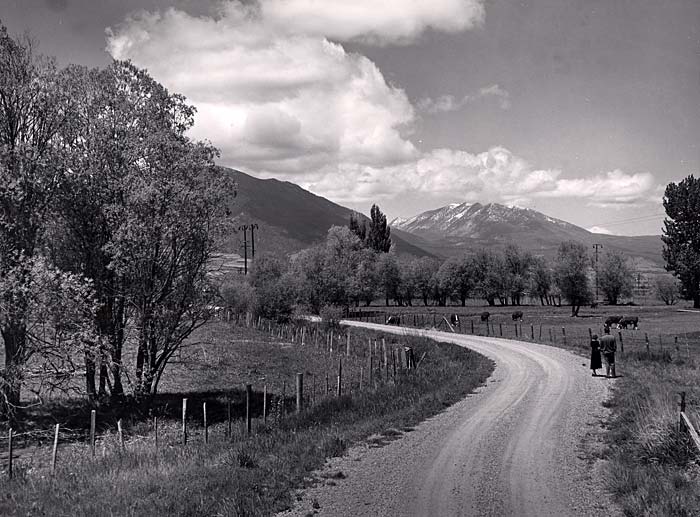 Chandler Hereford Ranch near Baker (4857). Enlarge image.
Chandler Hereford Ranch near Baker (4857). Enlarge image.
On the gravel road is ANTHONY LAKE, 21 m. (7,100 alt.), a vacation resort. (Forest camps, picnic grounds, commercial accommodations; boats and fishing tackle for hire). The resort is summer headquarters of the district forest ranger. Left from Anthony Lake 0.7 m. to BLACK LAKE (good fishing); right 0.3 m. to MUD LAKE (camp sites); and right 1.6 m. to GRANDE RONDE LAKE (boats for hire; camp sites).
Crossing a dividing ridge over which wagons of the pioneers struggled valiantly, the highway drops into the Grande Ronde Valley, called by the French Canadian trappers La Grande Vallee'. "About two in the afternoon," wrote Fremont, "we reached a high point of the dividing ridge, from which we obtained a good view of the Grand Rond a beautiful level basin, or mountain valley, covered with good grass on a rich soil, abundantly watered, and surrounded by high and well timbered mountains; and its name descriptive of its form the great circle. It is a place one of few we have seen in our journey so far where a farmer would delight to establish himself, if he were content to live in the seclusion it imposes."
Captain Bonneville, saw the valley in 1833 and reported: "Its sheltered situation, embosomed in mountains, renders it good pasturing ground in the winter time; when the elk come down to it in great numbers, driven out of the mountains by the snow. The Indians then resort to it to hunt. They likewise come to it in the summer to dig the camas root, of which it produces immense quantities. When the plant is in blossom, the Whole valley is tinted by its blue flowers, and looks like the ocean when overcast by a cloud."
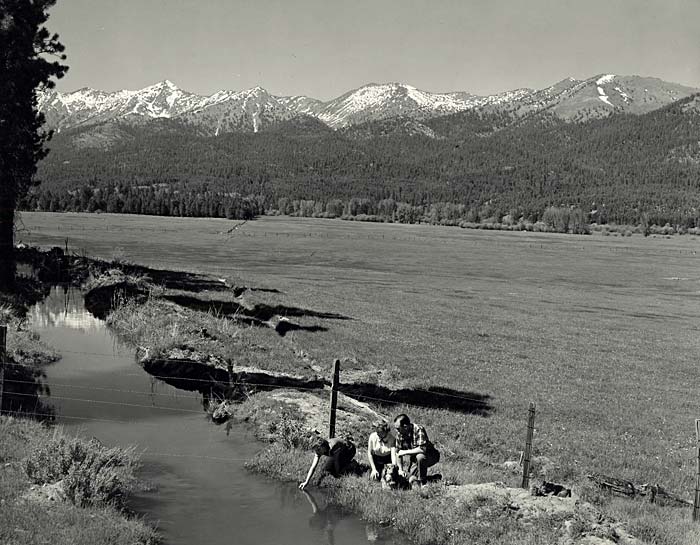 An irrigation ditch and field beneath the Elkhorn Mountains (4849). Enlarge image.
An irrigation ditch and field beneath the Elkhorn Mountains (4849). Enlarge image.
UNION,
116.8 m. (2,717 alt., 1,107 pop.), once the seat of Union County, was settled in 1862 by loyal citizens who perpetuated the spirit of their patriotism in the name of the town. Conrad Miller, the first settler, selected land a mile west of the present town in 1860. Union is the center of a rich agricultural and stock producing area. Catherine Creek, a good fishing stream, runs through the town. The 620 acre EASTERN OREGON STATE EXPERIMENT STATION is at the west city limits; here experiments are made in the growing and improving of grains, grasses, and forage crops. Here also are a dairy unit, a poultry unit, a five acre orchard, and truck garden plots.
At HOT LAKE, 122.4 m. (2,701 alt., 250 pop.), water gushing from springs has a temperature of 208 degrees, boiling point at this altitude. It is used for both medicinal and heating purposes in a large sanitorium. Irving says, in speaking of the eastbound Astorians under the command of Robert Stuart: "They passed close to . . . a great pool of water three hundred yards in circumference fed by a sulphur spring about ten feet in diameter boiling up in the corner. The vapor from this pool was extremely noisome, and tainted the air for a considerable distance. The place was frequented by elk, which were found in considerable numbers in the adjacent mountains, and their horns, shed in the springtime, were strewed in every direction about the pool."
LA GRANDE, 131.5 m. (2,784, alt., 8,050 pop.).
Railroad Station: Jefferson Ave., between Depot and Chestnut Sts., for Union Pacific Railroad.
Bus Station: Terminal, Washington Ave. and 7th St., for Union Pacific Stages and Inland Transit Lines.
Taxis: Rates 25c in City.
Accommodation: Hotels and tourist camps.
Information Service: La Grande Commercial Club and Oregon State Motor Association, Chestnut St. and Adams Ave.
Radio Station: KLBM (1420 kc.).
Motion Picture Houses: Two.
Athletic Fields: La Grande High School (flood lighted), 4th St., between K and M Sts.
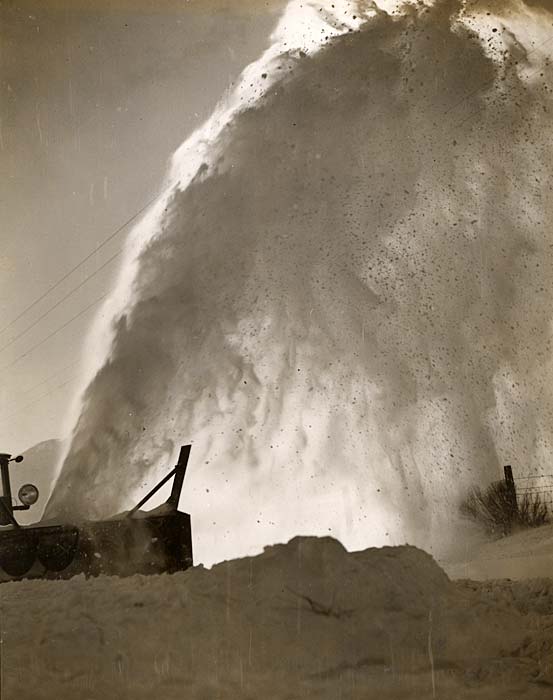 Snow removal showing snow geyser on Haines-Anthony road (g303). Enlarge image.
Snow removal showing snow geyser on Haines-Anthony road (g303). Enlarge image.
Tennis: Municipal Courts, Walnut St. and Washington Ave.
Golf: La Grande Country Club, 9 holes, $1 weekdays; $1.50 Sun., 3 m. NE. on State 82.
Swimming: Cone Pool (open air), 2 m. W. on US 30; Crystal Pool, N. 2nd St. Shooting: La Grande Gun Club, 3 m. E. on US 30.
Annual Events: Union County Pioneer Meeting, July; Grange Fair, September.
La Grande (2,784 alt., 8,050 pop.), seat of Union County, lies at the foot of the Blue Mountains near the western edge of the Grande Ronde Valley. Eastward rise the Wallowas, a low wall against the sky, serrated by bristling growths of fir and spruce. The town spreads out across a gently rising slope on the south bank of the Grande Ronde River, its wide streets pleasantly shaded by long rows of deciduous trees. Modern brick and concrete structures lend a metropolitan touch to the little city.
Ignoring the beauty and productivity of its level acres for a quarter of a century, settlers passed through the valley toward the Willamette. It was not until 1861 that a few settlers retraced their trail to stake the first claims in this region. They spent the winter about five miles north of the present city. In the following spring Ben Brown moved with his family to the south bank of the Grande Ronde River and built a log house at the foot of the mountains beside the overland trail. He converted his house to a tavern around which arose a small settlement known variously as Brown Town and Brownsville. Upon the establishment of a post office in 1863, the name was changed to La Grande, in recognition of the beauty of the scenery.
The town was incorporated in 1864. That same year the legislature created Union County, designating La Grande as temporary county seat. The erection of a two story frame courthouse started a county seat fight that lasted 20 years. No vote was taken until 1874 when the town of Union won the contest. Then the citizens of Union descended on La Grande, forcibly appropriated the county records, and carted them home. Ten years later another vote reversed the first plebiscite and La Grande citizens invaded Union and took back the records.
The city was once the home of Blue Mountain University, a Methodist college that ceased to function in 1884. During the Indian uprising of 1878, the alarmed populace took refuge behind thick brick walls of the old university building. The Indians did not enter the valley, but fear did not fully abate until Gen. O.O. Howard routed the tribes, killed Buffalo Horn, and drove Egan, the Paiute chieftain, from the state.
The Oregon Railway and Navigation line came in 1884, following a tangent across the prairie from the gap at Orodell, two miles to the north, to Pyle Canyon. La Grande, finding itself a mile off the railway, created a "New Town" beside the tracks, though "Old Town," as it is still known locally, remains an integral part of the city. The coming of the railroad opened a wider market for the products of the region and the location of division shops in the city insured a large and permanent payroll. Thereafter the population steadily increased.
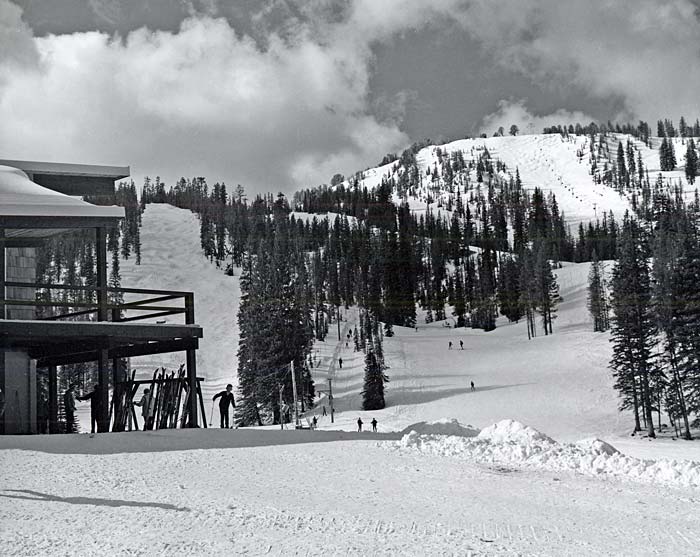 Anthony Lakes Ski Area (7361). Enlarge image.
Anthony Lakes Ski Area (7361). Enlarge image.
Here in her girlhood dwelt Ella Higginson (ca. 1860- ), author of three books of poems, a novel, some volumes of short stories, and many songs. Here also lived Mrs. Higginson's sister, Carrie Blake Morgan, poet and magazine writer; Kay Cleaver Strahan, writer of mystery stories; Bert Huffman (1870 ), poet and author of Echoes from the Grande Ronde; and T. T. Geer (1851-1924), who during his long residence in the town and county, accumulated much of the material for his volume of reminiscences, Fifty Years in Oregon.
Industrial life of La Grande centers on the railroad shops and two large sawmills. Creameries, cold storage and packing plants, and flouring mills provide additional employment. The principal products of the surrounding country are fruit, livestock, and lumber. La Grande is the chief shipping and distributing point for Union and Wallowa Counties and the starting point for hunting, fishing, and sight seeing trips into the Wallowa and Blue Mountains.
The city adopted the commission manager form of government in 1913.
The FIRST UNION COUNTY COURTHOUSE (private), SE. corner of 1st St. and B Ave., was erected in 1864 on the site of the former Ben Brown log cabin tavern. During the first year the lower floor of the courthouse was used as a print shop by the Democratic Grande Ronde Sentinel and the Republican Blue Mountain Times, the city's first newspapers; county offices were on the second floor. Later the second story was utilized as a schoolroom and sawdust was spread on the floor so that the noise of the children's feet would not disturb the county officials below. After the removal of the county seat to Union in 1874, the building was used as a church, as a store, and since 1876 as a residence.
The OREGON TRAIL MONUMENT, on a hillside at the west end of B Ave., is a slab of stone three feet high and 15 inches square, with "The Old Oregon Trail, 1843-1853" inscribed on the face. Scars of the old trail still remain slanting across the rugged slope. From the site is a panoramic view of the Grande Ronde Valley with the city in the foreground surrounded by checkered fields, and in the distance, Mount Emily and Mount Fanny lifting their crests above the Wallowa and Blue Mountains.
 Downtown La Grande (Oregon: End of the Trail, 1940). Enlarge image.
Downtown La Grande (Oregon: End of the Trail, 1940). Enlarge image.
The SITE OF BLUE MOUNTAIN UNIVERSITY, W. side of 4th St. between K and M Aves., is now the grounds of the La Grande high school and the Central grade school. In 1875 the University was organized under the auspices of the Columbia Conference of the Methodist Church. For a decade the college flourished, but in 1884 was discontinued when the conference was divided and the church endowment restricted. The property was leased for public school purposes and was purchased in 1889. The old La Grande high school, now the Central school, erected in 1899, was constructed partly of bricks from the old university hall, and the material from the old cornerstone was taken out and placed in the cornerstone of the new building.
UNION COUNTY COURTHOUSE, L Ave. between 5th and 6th Sts., constructed in 1904, is a two story red brick building, surrounded by a landscaped park. Here are the court records since 1864, which have suffered little loss or damage, despite the two forcible removals.
EASTERN OREGON COLLEGE OF EDUCATION, S. of L Ave. between 8th St. and Hill Ave., has a 30 acre campus on an eminence overlooking the city. It was established in 1929 and is the only Oregon institution of higher learning east of the Cascade Mountains. The central, or administrative building, a concrete structure of Italian Renaissance design, erected in 1929, provides offices, classrooms, a library, and an auditorium seating 600. Leading up to the building, which is 42 feet above the street level, is a wide stairway of buff colored concrete with ornamental balustrades. The J. H. Ackerman Training School, of similar architecture to the administration building, a laboratory school, sponsored jointly by School District No. 1 of Union County and the State of Oregon, was erected with Public Works Administration funds. One of Oregon's three teachers' training institutions, it serves an average of 350 students.
La Grande is at a junction with State 82.